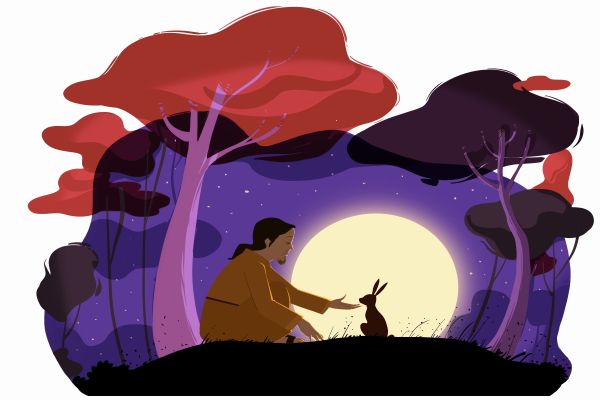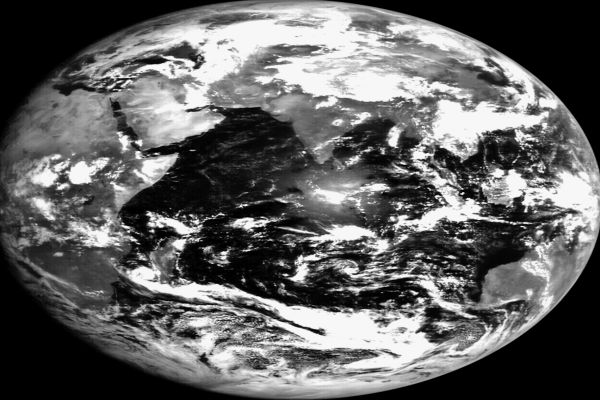On a lunar mission
- POSTED ON: 22 Jun, 2023
- TOTAL VIEWS: 420 Views
- POSTED BY: Jagadeesh Kanna | Article by R. Krithika
- ARTICLE POINTS: 150 Points
After listening to the story of Chandra and his 27 wives, Hanuman begins to wonder if there are any more stories that have a secret meaning.
Hanuman: Dad, the story about Chandra was very interesting. Are such stories told only in India?
Vaayu: Not at all. You will find them in every culture and country.
Hanuman: Really? Can you tell me more?
Vaayu: What do you see when you look at the Moon?
Hanuman: It is round and bright, with some dark patches.
Vaayu: When you look at the patches, can you make out any shape?
Hanuman: Hmmm, like some animal? A yazhi?
Vaayu: You see a yazhi but most people see a rabbit. In fact, people have created stories about how the rabbit got to the Moon. The Japanese version has a message.
Hanuman: Oh! Please tell me the story…

Illustration: Sahil Upalekar
Vaayu: The Japanese folktale is called ‘Tsuki no usagi’ or ‘The rabbit on the moon’. One day a poor man came to a forest and sat down under a tree. Seeing him look sad, three animals — a rabbit, a fox and a monkey — wanted to help him. The fox brought him fish from the stream, the monkey gave him fruits and nuts from the trees, but the poor old rabbit couldn’t find anything, except dry grass.
Hanuman: What did it do?
Vaayu: So, it built a fire with the dry grass and told the man, “I don’t have any food to offer you. But, since I any way have to die, you can eat me.” And it jumped into the fire.
Hanuman (shocked): What!
Vaayu: But the fire didn’t burn the rabbit. And the old man showed himself.
Hanuman: Who was he?
Vaayu: In the Japanese version, he is a god. In the Buddhist tales, he is Sakra, the ruler of the heavens. Pleased by the rabbit’s generosity, he grants it a boon. The rabbit replies, “I want to do something that will amaze the world. But now I am old. I don’t want anything.” The god says, “Dreams have no age limit. Never lose hope. Your love and generosity are bigger than the world. So, I will make sure the world sees you.” So, he puts the shape of the rabbit on the moon. The story is actually performed during the harvest season in Japan.
Hanuman: I love the story. Has this got to do with what the Moon is like? How do we actually know what it is like on the Moon?
Vaayu: Have you heard about Remote Sensing?
Hanuman: I have heard about remote control but what is remote sensing?
Vayu: There are two ways to research: one is in-situ and the other is remote sensing. For example, when you see a flower, how do you know what flower it is?
Hanuman: By seeing, touching, feeling or smelling it.
Vaayu: When you are “in the situation” and find out about something, it is called “in-situ”. When you see something remotely and can still tell what it is, it is called remote sensing.
Hanuman: I get it. The satellite pictures, TV channels and all are remote sensing.
Vaayu: Exactly. So to know more about the Moon, either you have to be like Neil Armstrong or Buzz Aldrin and go to the Moon and see what it’s like or you have to rely on satellites that go around the Moon and take images and send them back to Earth. India’s ISRO has sent up the Chandrayan satellite to find minerals on the Moon.
Hanuman: Will I be able to see the pictures that Chandrayan took?

Vaayu: Yes, of course. ISRO has made that data open source so that students and researchers have access to it. You can visit ISRO’s Indian Space Science Data Centre (ISSDC) and register to explore the moon. Use this link https://webapps.issdc.gov.in/CHBrowse/index.jsp
Hanuman runs to check out the Chandrayan pictures. He suddenly stops and comes back.
Hanuman: You told me the Japanese story? Does India have one too?
Vaayu: Yes, but we’ll keep that for later. First, you see the photos that Chandrayan sent back.
Curious, Hanuman runs to create his ID and to see the images of the Moon.
The author is the founder and CEO of Vaayusastra Aerospace, an IIT-Madras incubated ed-tech startup that offers Air Science workshops for children between five and 14 years.
Now that you have read this story, here is an activity for you. This grid contains 10 words connected with the Moon. Can you find them all?